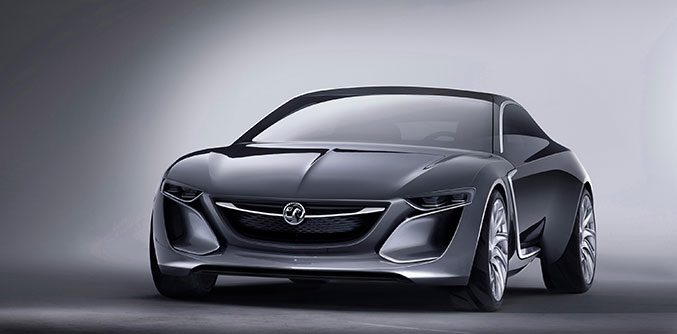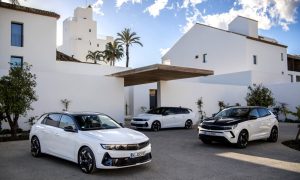 Opel/Vauxhall’s ground-breaking Monza Concept, the first car to feature cutting-edge LED projection infotainment and an evolution of the Ampera’s revolutionary powertrain, is set for its world premiere at the Frankfurt Motor Show next month.
Opel/Vauxhall’s ground-breaking Monza Concept, the first car to feature cutting-edge LED projection infotainment and an evolution of the Ampera’s revolutionary powertrain, is set for its world premiere at the Frankfurt Motor Show next month.
“The Monza Concept represents the Opel/Vauxhall car of tomorrow,” said Dr. Karl-Thomas Neumann, Opel/Vauxhall CEO. “On one hand, it embodies everything that already characterises Opel/Vauxhall – precision engineering combined with innovative technologies wrapped in captivating design. In addition, it addresses the themes that will be the development-focus of the next generation of Opel/Vauxhall cars: maximum connectivity and optimum efficiency.”
“Connectivity is demonstrated by a trailblazing LED projection technology for instrument and infotainment displays. Efficiency comes in many ways, with lightweight design, optimal use of interior space, and advanced powertrain technology. The Monza Concept is based on increasing electrification of the automobile in everyday driving, from range-extender to fuel cell. And as far as styling is concerned, we are expressing pure efficiency in a new, lean and athletic interpretation of our typical sculptural shapes. The Monza Concept is nothing less than our vision of the automotive future.”
DESIGN
The original Monza made its world premiere at the IAA back in 1977 for Vauxhall’s sister company Opel: it was a large coupé with a silky smooth-running six-cylinder engine. It went into production as the Vauxhall Royale in the UK, and was sold until 1982.
The new Monza Concept has a beautifully shaped bonnet with the distinctive centre fold continues the tradition of the Monza front with the typical Vauxhall crease. The large boomerang-shaped air intakes in front of the wheel arches complement the elegant chrome bar that holds the Griffin badge.
With the Monza Concept, the designers in Brit, Mark Adams’ team introduce a new interpretation of the sculptural design that first went into production with the Insignia. Distinctive lines, high-precision design and perfect sweeping contours remain the core of the evolving design philosophy.
But a new, athletic allure demonstrates the car’s overall efficiency. “This is the next bold step along our journey into the future, but at the same time we show that we have established a consistent design in which people can build trust,” said Mark Adams, Head of Opel/Vauxhall Design.

The sculptural surfaces of the 4.69 metre-long, four seat Monza Concept are modelled after ocean waves lapping on the shore. These flowing surfaces give a look of lightness, dramatically underlined by the side-sills that taper off in front of the rear wheel arches. This unique styling element is inspired by the lean physique and slim waist of a greyhound dog, running as if on tip-toes with powerful elegance. The design of the Monza Concept’s body sides enables easy entry and egress for front and rear-seat passengers, while underscoring the prominent, sporty rear wheel arches, which share the same width as those at the front.
The Monza Concept’s roof line is particularly sophisticated. At first it runs in a semi-circular form like a classic coupé’s, but then just before reaching the tailgate it sweeps slightly upwards. In spite of its sporty look and flat silhouette with a height of just 1.31 metres, there is neither loss of space in the luggage compartment – 500 litres in volume – nor constrained headroom for the passengers. This is due to the fact that the whole cockpit structure is around 15 centimetres lower than in conventional models. The Monza Concept offers the same airy passenger compartment as a mid-size car.
The expansive doors provide maximum functionality with spectacular views when opening. They swing up like the outstretched wings of a condor and offer an unobstructed view of the spacious, open passenger cabin (or the surroundings from the inside) thanks to the absence of a B-pillar.
FUTURISTIC CONNECTIVITY
Efficiency and connectivity are the main focus for development in the next generation of Vauxhall cars. The Monza Concept offers a fascinating preview of these developments. Once behind the wheel, the Monza Concept whisks you away into a completely new and unique world of instruments and infotainment.
The Monza Concept continues innovating with state-of-the-art LED projection technology. Drivers no longer find the conventional individual, separate monitors that display different information; instead, they face a wide, sculpted dashboard that sweeps from door to door, and is used as a single projection surface. Information and decorative elements are displayed on the surface, which the driver can customise according to his needs, taste or mood.
A total of 18 LED projectors create a continuous, adaptable multi-functional display – the first car in the world to feature this. Already established in the events arena, this technology has caused a sensation at major occasions such as the Queen’s Jubilee, and Opel/Vauxhall designers were first to think of implementing it in a passenger car. The 3D graphics are impressive, and reflect all important functions from precise vehicle and driver information to internet and communication options as well as decorative elements. Both the area displaying information and the background can be individually configured, and operation is via voice control and steering wheel controls.
Efficiency and clarity are also priorities here: when it came to how the displays present information, Opel/Vauxhall engineers focused on the best and most personal way to make relevant data available to the driver. The approach was “simplifying the multitude” and so details on the car, the navigation and the smartphone settings and connection only appear when necessary or desired. So drivers can use a wide range of information without being overwhelmed by text or images. This also makes the Monza Concept a model of future Human-Machine-Interface (HMI) systems, as its interior design is based on latest research findings in this field.
This also applies to the comprehensive smartphone connectivity in the Monza Concept. With three worlds of connectivity – called ME, US and ALL – drivers can focus solely on their driving experience, or get in touch with friends and family or even connect to the whole internet community. With ME the infotainment system virtually disconnects the drivers’ smartphone and prioritises the information relevant for the driving experience. US enables the passengers of the Monza Concept to connect with a group of selected people such as friends and family members: these can log-in to the car’s infotainment system with their own communication device and exchange information, music and images, chat and make appointments, etc. ALL goes beyond US. It allows the driver and virtually the whole outside world to connect. Drivers can for example spontaneously share their planned route online over a tablet or smartphone so that people can catch a ride with them along the way – enabling a new kind of instant car-sharing. With this trailblazing infotainment and connectivity technology, the Monza Concept shows how far ahead Opel/Vauxhall’s designers and engineers are thinking, so that the next generation of cars make their contribution to a harmonious, connected society.
The trendsetting sensor and connectivity technology in the Monza Concept has even more to offer: it gives a preview of the advancements in “Car-to-Car” and “Car-to-X” systems – prerequisites for future autonomous driving and areas in which the research department at Opel/Vauxhall is already intensively working. By comprehensively connecting road users, intercommunication can be enhanced, as can safety, because dangerous traffic situations are registered earlier and more accurately than before.
POWERTRAIN FLEXIBILITY
The Monza Concept is based on a modular design to allow highest-possible flexibility when selecting a propulsion system. A variety of sustainable powertrains based on increasing electrification of the automobile are available. For the Monza Concept set to be displayed at Frankfurt, engineers conceived an electric drive with a CNG (Compressed Natural Gas) range extender – a further development of the Ampera’s pioneering technology. The new-generation three-cylinder 1.0 SIDI turbo – which also makes its premiere at Frankfurt – takes over the task as range extender. But it does so with natural gas instead of petrol, further improving the car’s CO2 footprint. With its visionary approach, Opel/Vauxhall continues to combine the potential of electric propulsion with the benefits of the internal combustion engine.
“We have a clear vision of how Opel/Vauxhall cars will be in the future, and we have a clear strategy of how we will achieve this goal. The Monza Concept gives this strategy an unmistakable identity,” said Dr. Karl-Thomas Neumann. “It embodies what our customers can expect from us within the next years, not only in terms of design, but also in terms of efficiency and connectivity between drivers and the internet community. So it already anticipates future everyday automotive life, and serves as an important source of inspiration on the road to that destination.”
Source: Opel
Previous article
2014 Lexus IS Sport Sedan Designed to Deviate at 2013 Specialty


